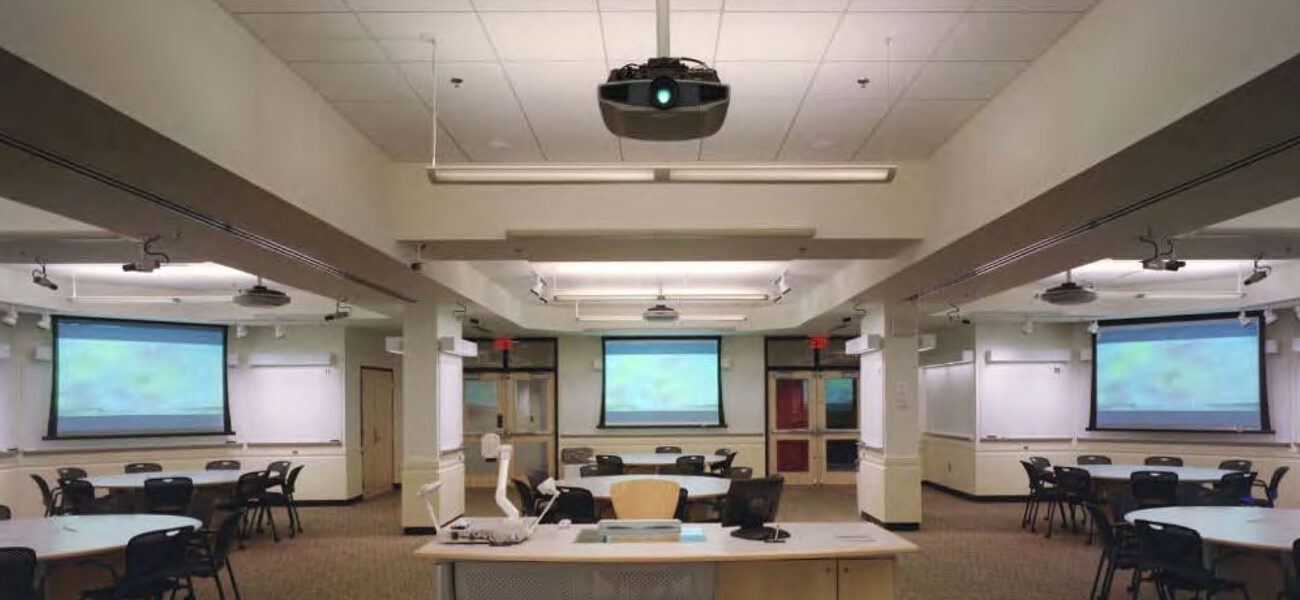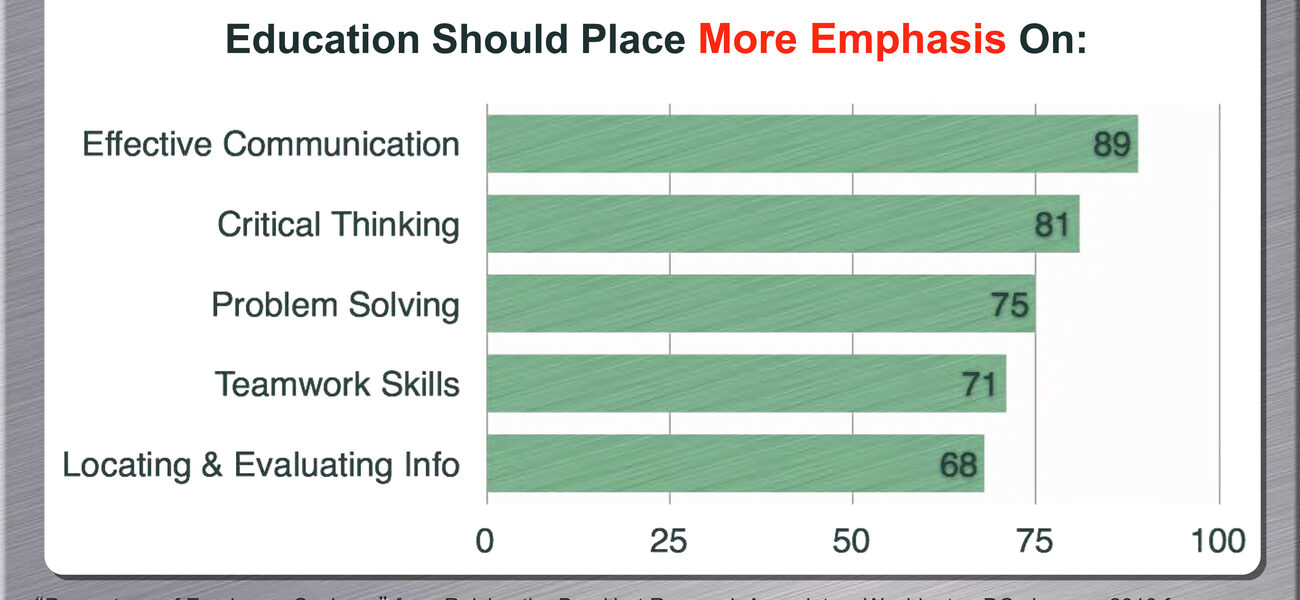A pedagogy pioneered at North Carolina State University (NCSU) is turning higher education upside down by redesigning the learning environment to foster interaction among today's technology-savvy students, and turning students into teachers in the process.
Student-Centered Active Learning Environment with Upside-down Pedagogies (SCALE-UP) was created to promote collaboration and improve the learning outcomes for physics students at NCSU. It is now used to teach a variety of courses at more than 150 colleges and universities throughout the United States, including the Massachusetts Institute of Technology. The driving force behind the concept is Robert Beichner, a physics professor at NCSU, who developed SCALE-UP to help education keep pace with the changing world in which today’s students live.
“The most obvious problem is that students aren’t learning as much as they should,” says Beichner. “A study published last year by the University of Chicago Press surveyed approximately 2,300 undergraduates and found that 36 percent showed no significant improvement in critical thinking, complex reasoning, or writing skills after four years of college. We aren’t reaching them.”
He notes that more high school students, and not just the upper academic tier, are enrolling in college today than they did when he graduated in the 1970s. This trend means that college professors must be prepared to teach students at all levels of academic performance, making it imperative to utilize pedagogies that reach everyone in the classroom.
“We need to raise our educational standards because of the changes taking place in technology. Education must place more emphasis on effective communication, critical thinking, problem solving, teamwork skills, and locating and evaluating information,” says Beichner. “Employers are looking for graduates with these skills, especially those who earn degrees in the STEM (science, technology, engineering, and mathematics) fields. Unfortunately, students are not getting the skills employers want, and not enough of these students are graduating.”
Extensive documentation verifies that SCALE-UP can improve students’ ability to understand course material and apply it to real-world problems, making them more viable candidates in tomorrow’s workplace. Creating a SCALE-UP environment, however, requires a willingness to think outside the box by redesigning existing classrooms to enable instructors to teach in ways that are vastly different from the traditional lecture format.
Designing the Non-Traditional Classroom
Convincing higher education administrators to spend the money necessary to redesign existing classrooms or to design new facilities can be challenging at a time when costs are increasing and funding is decreasing. Nationally, state funding for higher education was down more than 40 percent in 2011 compared to 1980, and the American Council on Education estimates that state investment in postsecondary education could reach zero in 2059. Many colleges and universities have old facilities and must use their financial resources to maintain aging infrastructures.
“The biggest challenges to change come from preconceptions that we all have about what a classroom should look like,” says Timothy Reynolds, a principal with the Science and Technology Group at Treanor Architects in Dallas, Texas, and Lawrence, Kansas. “We listen to all of the compelling evidence about the positive impacts of active learning environments or SCALE-UP classrooms and we still fall back to the same comfortable design solutions that we have created in the past. That does not serve our clients’ best interests nor does it solve the STEM educational challenges.”
Reynolds says old solutions, such as linear corridors, large auditorium-style classrooms, and tablet armchairs, must be replaced with more modern spaces and equipment. SCALE-UP facilities must be flexible and adaptable to support future changes in teaching methods and technology systems.
“The fact that SCALE-UP classrooms work on flat floors is a leg up in terms of overall facility flexibility,” he adds. “This can be enhanced by using raised-floor systems to distribute supply air, power, A/V, and telecommunications systems so that movable furniture can be located anywhere within the space.”
Developing the best design solutions for each facility means challenging preconceptions, asking tough questions, giving all stakeholders a voice, sharing knowledge, embracing flexibility and efficiency, leveraging all funding sources, focusing on students, and working together to identify priorities for efficiency, compliance, safety, STEM education, function, and aesthetics of the space.
“These are spaces that accommodate active learning, such as small-group and full-class collaborative interaction,” says David Livingood, also a principal and project manager at Treanor Architects. “We typically allow three to five more square feet per student for our active learning classrooms.
“One of the biggest challenges for architects might be caution or resistance in designing a new form of classroom,” he adds. “Unfortunately, the success of new environments to support changing educational pedagogy cannot typically be validated for several years after it is completed.
How and Why SCALE-UP Works
NCSU has compiled data comparing over 16,000 students in traditional and SCALE-UP physics classes. The findings show that the SCALE-UP environment improves problem-solving skills, conceptual learning, retention of classroom material, and overall attitude of students. The active learning environment benefits not only the students, but also the instructors and potential employers.
“Students learn more and they are better prepared for today’s job market. Instructors need less preparation time once the classroom activities are created, and teaching is more fun. Both teachers and students benefit from getting to know each other better,” says Beichner. “Universities have improved passing rates, so they are more efficient. Future employers get graduates who have practiced 21st Century skills like communication, teamwork, problem solving, and critical thinking,” he says.
The upside-down pedagogy plays an important role in creating the ideal learning landscape. Three aspects of the pedagogy flip the traditional idea of instruction. First, students become teachers by working together, sharing ideas, and helping each other solve problems. Second, content delivery takes place primarily outside the classroom, because students are responsible for learning the basic material and starting to work on it before they attend class. Advanced applications of the content and any material they do not understand from their preparatory work are discussed in class where they can receive assistance from the instructor and their peers. The third upside-down aspect involves the development of curricular materials: Instructional content is created by thinking about the end product. What does the instructor want students to achieve? Once this question is answered, the instructor develops the means to assess the students’ newly acquired skills and creates lessons to utilize those skills.
“It is a highly engaging learning environment. The instructor can get to every student, and there is a lot of accountability within the groups,” says Beichner. “There is an incredible amount of feedback from the students to the teacher. The instructor can easily tell where students are having difficulties.”
The Solution
Most of the classroom time is spent on three methods of active learning, which are referred to as “tangibles,” or observations; “visibles,” or computer simulations. Carefully structured teams share their work with the entire class in an environment that features 7-foot round tables, each of which has room for three teams of three students for a total of nine. Beichner designs his teams so that each table has a student from the top 10 percent of the class.
Beichner believes the tables are the most important “technology” in a SCALE-UP classroom. It took several years of research to determine what size and type of table best meets the goal of interactive learning. Bigger tables have too much wasted space in the center, and students are too far apart to collaborate. Smaller tables are not comfortable and do not provide enough space for the students’ notebooks, laptops, and lab equipment.
“The tables were designed to address a particular problem of facilitating interaction between the instructors and large numbers of students,” says Beichner.
Livingood notes the importance of taking advantage of all available technology without overwhelming a classroom.
“If you know in advance the kind of things you want students to be able to do, you need to provide the necessary technology to support those goals,” says Livingood. “You need to take advantage of all the advances that have been made in technology and recognize that most students are probably going to have their own technology.”
It is equally important to account for the support services and spaces that are necessary to make the technology work.
“It is a huge budgeting issue because not only does it involve the technology we see in the classroom, but also the equipment and people needed to support it,” says Reynolds. “You need to plan for this equipment and you need to change it relatively easily and quickly.”
When creating a SCALE-UP environment, it cannot be business as usual. Understand the issues and the goals you are trying to achieve. Accept the fact that there may be significant challenges, such as redesigning an existing facility or budgeting for necessary changes.
“Seek solutions that satisfy your unique needs,” suggests Beichner.
By Tracy Carbasho
This report is based on a presentation given by Beichner, Livingood, and Reynolds at Tradeline’s 2012 College and University Science Facilities conference.


